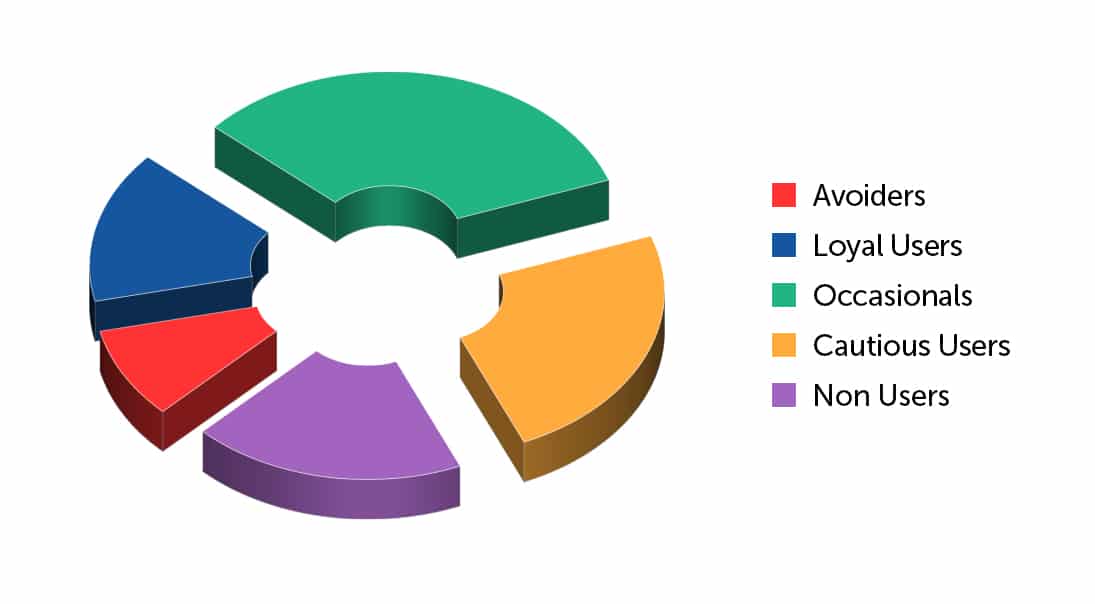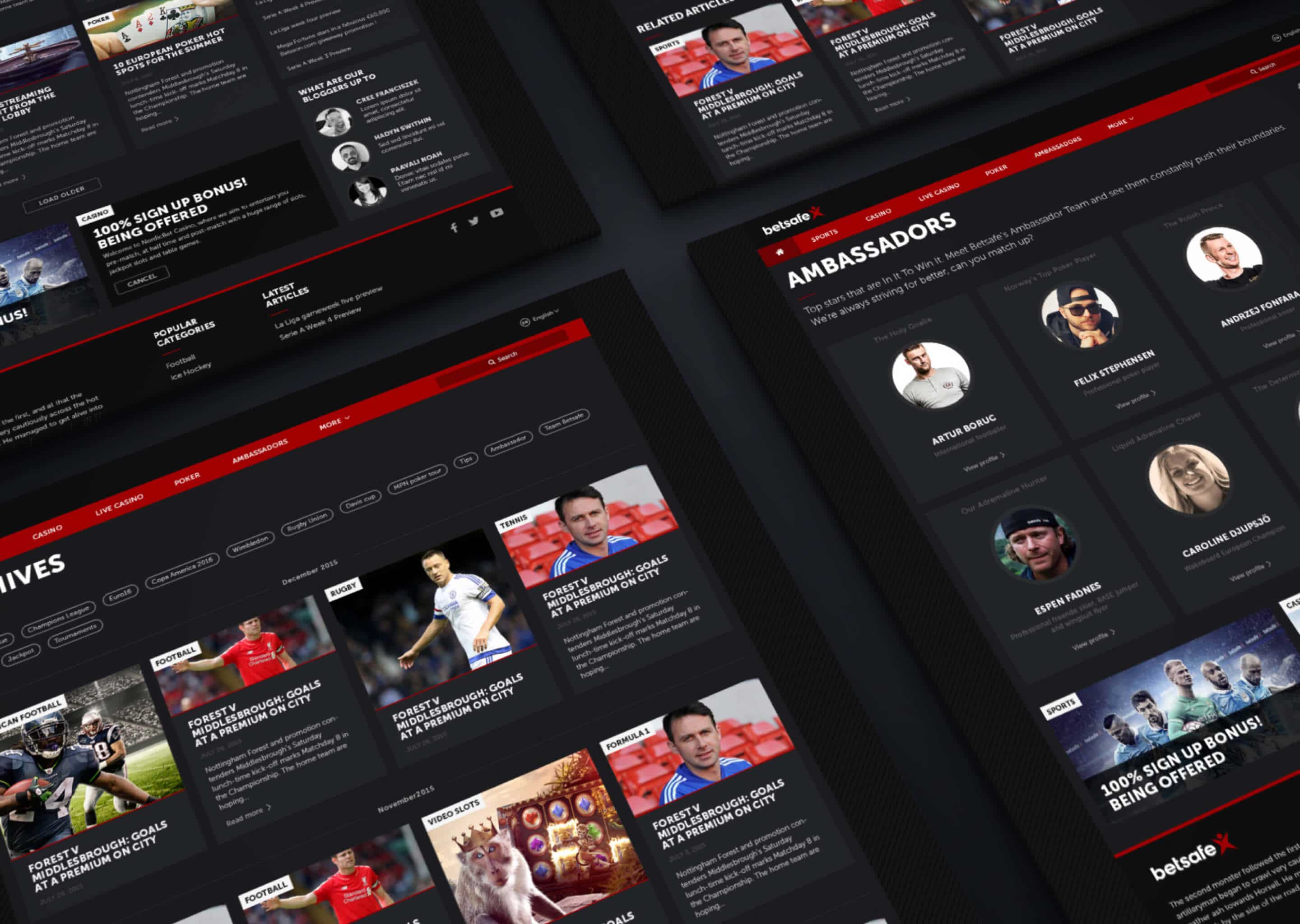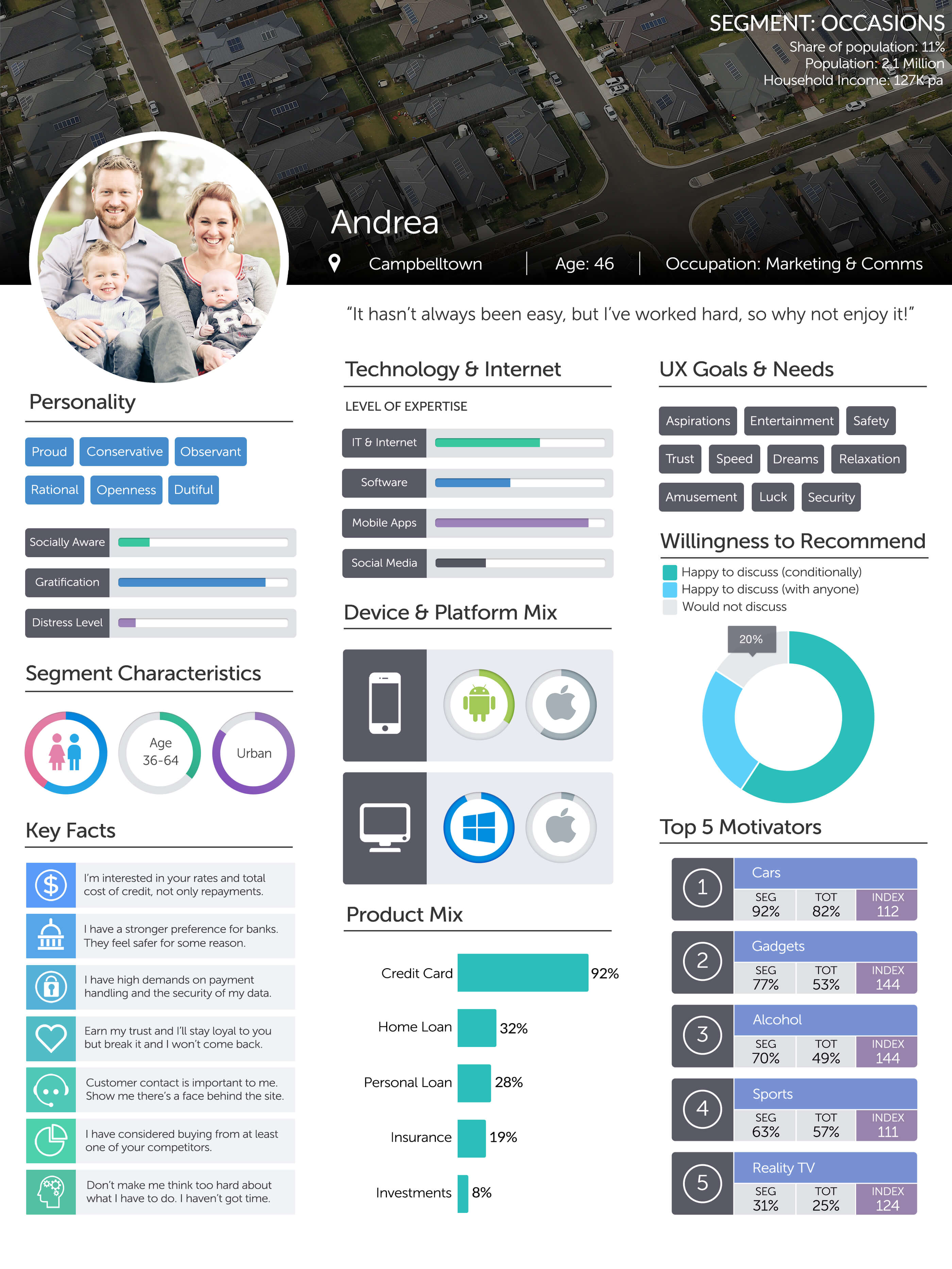Segmentation & User Personas
Segmentation & User Personas
Brand Platform Development
Brand Platform Development
Introduction of User Personas through a meaningful and accurate segmentation exercise
User Personas through a meaningful and accurate segmentation exercise
This segmentation project was delivered for an entertainment business which has over 1000 employees, 250K active users and achieves an annual turnover of over AUD 240 million. It owns a number of companies and brands which operate entertainment and gaming products made available to consumers through partnerships and through its owned digital channels.
This segmentation project was delivered for an entertainment business which has over 1000 employees, 250K active users and achieves an annual turnover of over AUD 240 million. It owns a number of companies and brands which operate entertainment and gaming products made available to consumers through partnerships and through its owned digital channels.
My Role
Reporting to the Group CPO and CXO, I was tasked with building a Group wide, Voice of Customer and broader CX programme. This was one of a number of strategic initiatives that I executed as part of my CX roadmap and was fully accountable for the project and it's operational activation.
My Role
Reporting to the Group CPO and CXO, I was tasked with building a Group wide, Voice of Customer and broader CX programme. This was one of a number of strategic initiatives that I executed as part of my CX roadmap and was fully accountable for the project and it's operational activation.
Reporting to the Group CPO and CXO, I was tasked with building a Group wide, Voice of Customer and broader CX programme. This was one of a number of strategic initiatives that I executed as part of my CX roadmap and was fully accountable for the project and it's operational activation.
The Team
- Head Of Customer Experience (me)
- Consumer Research Manager
- Supporting research agency
The Team
- Head Of Customer Experience (me)
- Consumer Research Manager
- Supporting research agency
Stakeholders
- Board of Directors
- The C Suite
- Core Brand MDs
- Marketers
- Product Managers and Owners
- Tech & Design Teams
Stakeholders
- Board of Directors
- The C Suite
- Core Brand MDs
- Marketers
- Product Managers and Owners
- Tech & Design Teams
Timeframe
- Initial phase: 6 months
- Ongoing operational maturity
Timeframe
- Initial phase: 6 months
- Ongoing operational maturity
The Problem
The Problem
Throughout the previous 3-5 years, this publically listed, large cap entertainment business had seen an impressive period of rapid growth which had been driven through both organic performance and company acquisitions. The acquisition component brought about new and expected challenges as the business began to consolidate the various brands it had acquired and needed to quickly understand how to use inherited resources more effectively, make better strategic marketing decisions and continue to grow revenue through a Group wide, multiple-brand strategy.
At this point in the company's maturity, user classification had been very much product and revenue centric rather than consumer centric which produced a customer view that was essentially high value (VIP) versus mass. Design workflow lacked collaboration, was directed by individual preference and a ‘design by committee’ approach. The customer was not represented anywhere in the structure or the process.
Throughout the previous 3-5 years, this publically listed, large cap entertainment business had seen an impressive period of rapid growth which had been driven through both organic performance and company acquisitions. The acquisition component brought about new and expected challenges as the business began to consolidate the various brands it had acquired and needed to quickly understand how to use inherited resources more effectively, make better strategic marketing decisions and continue to grow revenue through a Group wide, multiple-brand strategy.
At this point in the company's maturity, user classification had been very much product and revenue centric rather than consumer centric which produced a customer view that was essentially high value (VIP) versus mass. Design workflow lacked collaboration, was directed by individual preference and a ‘design by committee’ approach. The customer was not represented anywhere in the structure or the process.
Problem Definition
Problem Definition
- Product and revenue centric rather than consumer centric
- Customer view was mainly high value versus mass
- Marketing to a mass market with inherited brands
- Poor use of resources
- Customer not represented
- Product and revenue centric rather than consumer centric
- Customer view was mainly high value versus mass
- Marketing to a mass market with inherited brands
- Poor use of resources
- Customer not represented
Targeted Outcomes
Targeted Outcomes
- Understand and identify current and potential customers
- Measurement of segment size
- Determine brand strategies, marketing and comms platforms
- Deliver insight on new product categories
- Produce user personas to support segmentation
- Understand and identify current and potential customers
- Measurement of segment size
- Determine brand strategies, marketing and comms platforms
- Deliver insight on new product categories
- Produce user personas to support segmentation
- Understand and identify current and potential customers
- Measurement of segment size
- Determine brand strategies, marketing and comms platforms
- Deliver insight on new product categories
- Produce user personas to support segmentation
The Process
The Process
My goal with this segmentation study was to deliver insightful and actionable results that would be adopted across the various functions of the business. Therefore, it was critical to lead a highly collaborative approach at every stage of the process to allow for input into the survey, segment question inputs, selection of a segment solution, and even the selection of appropriate names for each segment. I wanted the process to produce a data driven tool which should speak the language of Product Development, Marketing & Communication platforms as one. I have found that, in Enterprise level businesses, collaboration and alignment between these functions is often challenging but also critical in delivering on long term product engagement objectives (both revenue growth and customer retention) so I wanted to ensure this was adopted properly throughout these functions.
The process was divided into five main categories of activity and each step was actioned in a linear way with the exception of the operational activation and evaluation which was an ongoing iterative loop.
My goal with this segmentation study was to deliver insightful and actionable results that would be adopted across the various functions of the business. Therefore, it was critical to lead a highly collaborative approach at every stage of the process to allow for input into the survey, segment question inputs, selection of a segment solution, and even the selection of appropriate names for each segment. I wanted the process to produce a data driven tool which should speak the language of Product Development, Marketing & Communication platforms as one. I have found that, in Enterprise level businesses, collaboration and alignment between these functions is often challenging but also critical in delivering on long term product engagement objectives (both revenue growth and customer retention) so I wanted to ensure this was adopted properly throughout these functions.
The process was divided into five main categories of activity and each step was actioned in a linear way with the exception of the operational activation and evaluation which was an ongoing iterative loop.

1. Consumer & Category Understanding
1. Consumer & Category Understanding
Our approach to this phase began with needs-based segmentation, which aims to classify customer segments based on a common set of needs (met or unmet) and/or purchase behaviours. A strategy based solely on traditional segmentation, using only demographic and firmographic elements (and not needs) often results in failure because the method does not capture WHY customers buy certain products and services over others. Needs-based segmentation is therefore;
- the most actionable
- more stable over time
- less likely to produce local differences between target countries
Our approach to this phase began with needs-based segmentation, which aims to classify customer segments based on a common set of needs (met or unmet) and/or purchase behaviours. A strategy based solely on traditional segmentation, using only demographic and firmographic elements (and not needs) often results in failure because the method does not capture WHY customers buy certain products and services over others. Needs-based segmentation is therefore;
- the most actionable
- more stable over time
- less likely to produce local differences between target countries
Activities & Outputs
Activities & Outputs
In depth, explorative interviews
My team and I, supported by outsource partners performed a series of highly qualitative, in depth interviews to explore the needs and attitudes towards the category. We used a wide range of question topics which were designed to assess product usage, attitudes towards the organization and a variety of lifestyle aspects tailored to the needs of this sector. Some of the specific topic areas we explored included:
- Brand/product awareness
- Game participation and spending
- Lapsed player analysis
- Game play habits
- Game attributes and their importance
- Advertising and communications
- Game motivations
- Corporate image
- Policy and social issues
- Attitudes toward various types of gaming
- Lifestyle indicators
- Technology
- Social media
In depth, explorative interviews
My team and I, supported by outsource partners performed a series of highly qualitative, in depth interviews to explore the needs and attitudes towards the category. We used a wide range of question topics which were designed to assess product usage, attitudes towards the organization and a variety of lifestyle aspects tailored to the needs of this sector. Some of the specific topic areas we explored included:
- Brand/product awareness
- Game participation and spending
- Lapsed player analysis
- Game play habits
- Game attributes and their importance
- Advertising and communications
- Game motivations
- Corporate image
- Policy and social issues
- Attitudes toward various types of gaming
- Lifestyle indicators
- Technology
- Social media
Online surveys
Using the insights gathered from the interviews, we designed and executed a 25 minute long online survey in order to gather a quantitative dataset. We were careful to gather a sample size that would produce a satisfactory confidence interval and significance level so we could conclude that the results could be scaled to reflect the characteristics of the broader market. The sample size for this study was 2500 respondants and was based on national representative samples and the customer database. The survey covered the following topics;
- Category behaviour and spending
- Context of gaming
- Demographics and customer value
- Gaming online concerns
- Needs and attitudes
- Category drivers
- Brand image
NOTE: The target markets were not native English speaking so we also had language and translation challenges to solve with these activities hence the use of supporting local agencies.
Online surveys
Using the insights gathered from the interviews, we designed and executed a 25 minute long online survey in order to gather a quantitative dataset. We were careful to gather a sample size that would produce a satisfactory confidence interval and significance level so we could conclude that the results could be scaled to reflect the characteristics of the broader market. The sample size for this study was 2500 respondants and was based on national representative samples and the customer database. The survey covered the following topics;
- Category behaviour and spending
- Context of gaming
- Demographics and customer value
- Gaming online concerns
- Needs and attitudes
- Category drivers
- Brand image
NOTE: The target markets were not native English speaking so we also had language and translation challenges to solve with these activities hence the use of supporting local agencies.
2. Market Segmentation
This phase was purely analytical and took 2 months to complete. The data resulting from this report is the intellectual property of the business that invested in it so cannot be published or shared in any way (however, contact me to talk more about methodology and the outcomes within the boundaries of NDA). To demonstrate, the chart on the right is an example of a segmentation outcome as it was delivered through this project.
The next step was to map the attributes of our customer segments to Personas. To be able to make personas actionable, I wanted also to map them to the data held in the businesses engagement platform and build this data into our target group selection.
This phase was purely analytical and took 2 months to complete. The data resulting from this report is the intellectual property of the business that invested in it so cannot be published or shared in any way (however, contact me to talk more about methodology and the outcomes within the boundaries of NDA). To demonstrate, the chart below is an example of a segmentation outcome as it was delivered through this project.
The next step was to map the attributes of our customer segments to Personas. To be able to make personas actionable, I wanted also to map them to the data held in the businesses engagement platform and build this data into our target group selection.

3. Target Group Selection
The segmentation exercise produced a range of different needs-based consumer segments which we identifed as driving purchasing behaviour. I wanted to establish ONE common model for all markets so the segments were not based on behaviours directly. Instead they were based on the underlying needs that we identified as a predictor for driving purchasing behaviour.
The segments were designed to meet the following criteria:
- Clear distinction - heterogeneous between segments and homogeneous within segments
- Targetable - communication channels, media and product platforms
- Sizeable - large enough to be a candidate for action
- Econometric - value and size differentiation
- Robust - viable for long term use and able to refresh in future
Below is an example of a persona that was produced from this study with real data not represented in any way. As well as being used to guide the design process, from requirements definition through to launch, these personas supported the role out of a Group wide multi-brand marketing and communications strategy.
Want to know more? Contact me for a more thorough presentation which will include the following:
A more detailed discussion on methodology and analytics.
A walk through the components of the persona.
A more detailed discussion on the resulting data.
Effective use of the personas produced and the associated challenges seen at Enterprise level.
Want to know more? Contact me for a more thorough presentation which will include the following:
A more detailed discussion on methodology and analytics.
A walk through the components of the persona.
A more detailed discussion on the resulting data.
Effective use of the personas produced and the associated challenges seen at Enterprise level.
You might also be interested in

Sports UX Benchmarking StudyResearch

Betsafe Product RedesignProduct Design
What people are saying

Marcello Viotti
Head of Product Design
"Daniel is a one of a kind person and by far the best and most knowledgeable manager I have had in my entire career. He has been able to enhance my skills like no other before, using a rewarding and proactive approach towards all his colleagues, he is able to make you work at your 100% without feeling any effort."

Chris Azzopardi
Product Manager
"Daniel is not a follower, but a great leader who brings a lot of knowledge and experience to the table. An exceptional manager with outstanding communication skills, ready to be seen as 'the bad guy' if that is what it takes. Questions the status quo on a daily bases to make sure the company has better processes, quality and delivery"

Adrian Slate
General Manager
"He is the kind of leader that will protect & guide you in the right path, discussing and brainstorming together with the team in order to take the right decisions and in a timely manner. The kind of person that focuses on quality over quantity. Being flexible, understandable and focusing on the human part as much as he focuses on the business part."

Theador Tabakov
Product Manager
"In all of my career I have never had a manager like Daniel. In the time working with him, he became my role model on what type of a People Manager I want to become. Working with him and seeing how he organizes, leads and inspires a team was something I had never seen before. His approach to problem solving is truly remarkable"

Regan Hobbs
Managing Director
"Daniel has a great grounding in design, UX and UI methodologies, and has used an academic approach to usher in great improvements in our business, not only in output from his team, but also the underlying process."

Chris Zammit Dimech
Head of Creatives
"What stands out in Daniel as a leader is his ability to recognise quality in people, work with them and enhance their skills. I find this to be a rare quality and his guidance helped me a lot in achieving my targets and goals."

Terence Neil
Head of Optimisation
"Daniel’s in-depth knowledge of his chosen field as well as his ability to operate at both strategic and tactical levels has led to him being one of the most sought after consultants in our organisation today."

Sebastien Van Schalkwyk
Managing Director EMEA
"Daniel is one of the most customer centric designers I've had the pleasure of working with. From day one it was a breath of fresh air listening to Daniel give expert advice on user centricity and it's practical application."

Home · Profile · Résumé · Contact
Daniel Blackmore © 2023
Daniel is an experienced Product leader with a successful track record in designing, building, shipping and optimising products across acquisition, retention, and monetization levers.
